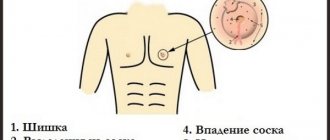Classification
Chemotherapy for the breast is performed at all stages of treatment. Depending on the stage, classification occurs. Here are some types of “chemistry” performed:
- Therapeutic . The use of chemotherapy as the main method of treating the tumor. The goal of this treatment is to stop the process of tumor division, reduce its size, and also fight the metastases that have appeared in the patient’s body.
- Adjuvant . It is used not as the main, but an additional method of treatment or even as a preventive measure. It can be used before and after surgery. In any case, it is used for operable formations. Accordingly, the task is either to reduce the size of the tumor before surgery, or to destroy its cancer cells after surgery.
- Induction, neoadjuvant – used for inoperable cases. One of the common tasks is to reduce the size of the tumor to an operable form for its further removal.
- Preventive – usually carried out to prevent possible relapses.
Carrying out chemotherapy for breast cancer: indications, preparation, techniques used
May 18
The goal of chemotherapy is to destroy cancer cells using special drugs. It is used as the main or auxiliary method of fighting for the health and life of cancer patients. Treatment improves the prognosis and sometimes even increases the chances of a full recovery for women facing such a serious illness as breast cancer. The doctor approaches the prescription of drugs, determining dosages and choosing a regimen strictly individually, taking into account the patient’s condition and existing contraindications.
Peculiarities of chemotherapy During the treatment process, cytostatic drugs are introduced into the patient’s body. These toxic substances are capable of destroying cancer cells, that is, preventing the further development of malignant tumors and the formation of metastases. The effect of each drug has specific characteristics. In some cases, for breast cancer, it is necessary to use them in various combinations, to carry out treatment according to certain regimens, in order for the effectiveness of chemotherapy to be maximum. Cytostatics have a systemic effect on the body. These substances are distributed throughout the body through the blood vessels, so cancer cells die not only in the tumor itself, but also in other parts of the body where they enter with the blood.
For breast cancer, chemotherapy can be prescribed as an independent treatment, or in combination with the use of surgical techniques and radiation.
Cytostatic drugs are available in various dosage forms. They are taken in the form of tablets or introduced into the body by injection (usually intravenous). The effectiveness of treatment is much higher if it is started at an early stage of the disease. The effectiveness of chemotherapy also depends on the type of tumor and its sensitivity to drugs of this type.
Indications and contraindications Chemotherapy is indicated in the following cases:
there is a possibility of relapse of the disease after surgical removal of a malignant breast tumor; newly formed cancer cells are detected; it is necessary to prevent the formation of metastases; histological analysis showed the presence of malignant cells in the lymph nodes; it is necessary to stop the development of a cancerous tumor before performing surgery to remove it for stage 1 and 2 cancer; reducing the size of the tumor allows you to reduce the volume of surgical intervention and preserve as much healthy breast tissue as possible; It is possible to reduce the size of the tumor in the final stages of breast cancer and make it operable. The need to prescribe cytostatics is determined by the attending oncologist. At the same time, he takes into account the stage of development of the disease, the age of the patient, the nature of the hormonal levels in her body, the size, location and growth rate of the tumor, and the condition of other organs. The doctor compares the effectiveness of such treatment and the severity of possible complications.
Chemotherapy for breast cancer is not prescribed if the tumor is hormonally dependent. Similar neoplasms occur in young women as a result of hyperestrogenism. In such a situation, chemotherapy is contraindicated, as it is completely ineffective. It is necessary, first of all, to carry out medical or surgical treatment of the patient to suppress ovarian function, reduce the production of estrogen and weaken their effect on the body.
What types of chemotherapy exist When treating breast cancer, the possibility of carrying out such therapy, the complexity of the technique and the duration of use of cytostatics depend, first of all, on the stage of tumor development in the mammary gland and the sensitivity of cancer cells to the effects of such drugs.
There are several types of treatment.
Adjuvant (additional or prophylactic). It is prescribed after surgical removal of the tumor. With the help of drugs, cancer cells are destroyed that could remain in the body and give rise to the development of a new malignant process. It is carried out at the discretion of the doctor, even if all manifestations of the disease disappear after the operation. No additional tests are required to confirm the presence or absence of suspicious cells in the patient’s body. The patient may refuse preventive chemotherapy at her own risk.
Neoadjuvant. Chemotherapy for breast cancer is prescribed before surgery. This is often the way to reduce the size of a clearly localized tumor. This makes it possible to preserve a large part of the mammary gland during subsequent surgery. During treatment, the sensitivity of the tumor to various cytostatic drugs is studied. However, in some cases, after the course it turns out that chemotherapy is ineffective. At the same time, wasting time on such treatment can aggravate the situation. Delaying the operation is dangerous because the development of the tumor enters a more complex stage.
Therapeutic. It is carried out in the case when the patient has metastases in other organs due to breast cancer (in case of generalized cancer). Carrying out courses of chemotherapy can prevent further spread of metastatic tumors and improve the patient’s quality and life expectancy.
Induction. It is prescribed when it is impossible to remove the tumor because it is too large and there are no clear boundaries between healthy and diseased breast tissue. Tumors sensitive to the effects of cytostatics decrease in size after treatment, and sometimes it becomes possible to remove them.
Drugs used in chemotherapy For breast cancer, drugs of several groups are used, differing in different mechanisms of action. Their choice depends on the goals of chemotherapy. The number of courses of treatment is determined depending on the stage of cancer development, the sensitivity of the tumor to drugs, and the individual reaction of the patient’s body.
Alkylating cytostatics (for example, cyclophosphamide, dipine, cisplatin). Like radioactive rays, they destroy proteins involved in the formation of cancer cells. Antimetabolites (5-fluorouracil, gemzar) destroy the DNA of cancer cells.
Anticancer antibiotics (have nothing in common with conventional antimicrobial agents). They prevent tumor cell division and growth. These drugs include andymycin, bruneomycin, rubomycin, adriablastin.
Taxanes (paclitaxel, docetaxel). They are prescribed to restore the ability of cells to divide normally and eliminate the possibility of cancer progression.
Drug regimens An individual treatment regimen is drawn up for each patient. In this case, the body’s reaction is taken into account and the possible effectiveness is assessed. For example, the following combinations of drugs are used:
fluorouracil + adriablastin + cyclophosphamide (FAC regimen); cyclophosphamide + methotrexate + fluorouracil (CMF regimen); cyclophosphamide + adriablastin + fluorouracil (CAF regimen); The TAC regimen is considered especially effective: taxel (docetaxel) + adriamycin (doxorubicin) + cyclophosphamide. Doses are calculated taking into account the woman’s body weight and height.
Red chemotherapy The most severe toxic effect on the body occurs during the so-called “red chemotherapy”. It is called so because red solutions of anthracyclines (antibiotics) are used. The use of a combination of such drugs allows in 50-70% of complex cases to achieve an improvement in the condition of patients and a significant reduction in mortality.
Preparation for implementation Before prescribing chemotherapy for breast cancer, the doctor tells the patient about the feasibility and possibilities of this treatment method, warns what the consequences may be if it is not carried out. In this case, the woman must be informed about complications during treatment. She is warned of the serious side effects that such toxic drugs have.
Immediately before starting chemotherapy, your general health status is examined. To do this, a coagulogram (clotting test) is performed, a general blood test is performed, and a biochemical test for creatinine (its level is used to judge the functioning of the kidneys). Blood pressure, pulse rate, temperature are measured.
Carrying out chemotherapy The patient takes the pills prescribed by the doctor strictly according to the regimen at home. Intravenous administration of drugs is performed in the hospital. The solution is administered through a catheter, which is then removed, after which the patient is sent home.
A patient is hospitalized only if, to alleviate her condition during cancer treatment, it is necessary to administer antiemetics intravenously, since their use in tablet form is physically impossible due to indomitable vomiting. Sedatives and tranquilizers may be prescribed to alleviate the patient's psychological condition. They help relieve her of fear before the next procedure.
A full course of treatment for cancer may consist of several cycles, depending on the severity of the disease and the goals of chemotherapy (there may be 2, 4 or more). The question of the total duration of treatment is decided by the oncologist. Therapy is carried out over several weeks or months. There is a break between cycles.
Possible complications and consequences Chemotherapy drugs do not have a selective effect. They destroy not only malignant cells, but also healthy ones. The forced use of strong toxins in the treatment of breast cancer is accompanied by side effects that arise due to damage to the cells of vital organs (kidneys, heart, liver, blood vessels, bone marrow and others).
The most well-known consequences of chemotherapy for breast cancer are nausea and vomiting, baldness, deterioration of the blood (anemia), bruising, bleeding gums, nosebleeds (due to thinning of the vascular walls). You feel constant fatigue and weakness.
Many patients suffer from indigestion (constipation or diarrhea). Young women often experience menstrual irregularities. A weakening of ovarian function may occur, leading to the disappearance of menstruation. Decreased immunity leads to increased susceptibility to various infections (for example, pathogens of pneumonia, tetanus).
Disturbances in the functioning of the pancreas and thyroid glands, liver, bladder, and symptoms of renal failure may occur. Pain in the side and back may occur. The condition of the teeth worsens and the teeth set on edge.
The intensity of unpleasant side effects during chemotherapy treatment of cancer varies from woman to woman and depends on the individual sensitivity of the body, the state of the nervous system, and the stage of breast disease. Nausea and vomiting occur as a result of the effects of toxins on the mucous membranes of the stomach and intestines. Most often, this symptom appears in young women, as well as in those who are accustomed to smoking and drinking alcohol.
The listed side effects are short-term and usually disappear after stopping the medication. As a rule, their occurrence is facilitated by the presence of prerequisites (chronic diseases of the kidneys, intestines, stomach, aggravated by “chemotherapy”).
Drugs
Modern medicine is rich in drugs for chemotherapy. Many of them do not even have a general effect on the body with many side effects, but affect specifically malignant cells. This type of therapy is also called targeted therapy.
We have already looked in detail at the general categories and specific drugs used in chemotherapy. It’s worth noting here that there is nothing special about it. Therefore, once again we briefly mention the drugs here:
- Alkylating, cytostatic - affect DNA, destroy cells similar to radiation therapy. A typical representative for breast cancer is cyclophosphamide.
- Antimetabolites - influence the process of cancer cell division, or more precisely, the destruction of cells during this process. Examples – Gemcitabine, 5-fluorouracil.
- Taxanes – effects on cell mycortubules. Examples – Paclitaxel, Docetaxel.
- Cancer antibiotics - but do not confuse them with ordinary ones - act to increase the time of cell division. Example – Adriamycin.
Typically, these drugs are used in combination as prescribed by the attending physician. Here are some real drug treatment regimens:
- CMF – Cyclophosphamide + Methotrexate + Fluorouracil.
- FAC – Fluorouracil + Adriablastin + Cyclophosphamide.
- CAF – Cyclophosphamide + Adriablastin + Fluorouracil.
- Taxanes – Docetaxel + Paclitaxel.
Chemistry colors
Chemotherapy drugs and the therapy itself are also divided by color. So, for example, red is the strongest, most effective, based on alkylating drugs, but at the same time the side effects from it are the greatest. Here are examples of other types of chemistry by color:
- Red – Epirubicin
- Blue – Cyclophosphamide
- Yellow – Fluorouracil
- White – Taxol
Typically, the doctor alternates types of chemotherapy to achieve the maximum effect of treating the breast. In addition, such alternation will not only ease the load on the patient’s body, but will also prevent possible addiction to the drugs.
Red therapy is the main choice in the treatment of breast cancer. It is the use of this chemistry in recent years that has significantly reduced mortality from this type of oncology.
Chemotherapy red and white
If oncologists divide the drug therapy they carry out for a particular tumor pathology according to the composition of the medications, then patients classify the drugs according to the color of the substance that is administered to them.
Red chemotherapy is, of course, recognized as the most effective, but also the most severe - after it there is a significant decrease in the immune barriers of patients.
Generally recognized colors of antitumor therapy
The main goal of chemotherapy is to suppress the growth and destroy cancer cells. However, during antitumor treatment, healthy tissues are also affected. This is precisely why experts explain the large number of side effects from such treatment.
Today, it is customary to classify medications that can destroy mutated structural particles according to their pharmacological composition, as well as their coloring, into the following subgroups:
- For red chemistry, Indarubicin, Epirubicin, and Doxorubicin are used. Medicines have a pronounced general toxic effect on the patient’s body.
- For yellow chemotherapy, Fluorouracil, Metatrexate or Cyclophosphamide are used. This treatment is less toxic and has fewer side effects.
- Blue chemistry is the drugs Mitoxantrone or Mitomycin.
- White chemotherapy also stands out - it includes Taxotel and Taxol.
As a rule, treatment of a cancer lesion is complex, since the complete destruction of mutated cells requires comprehensive action.
Features of the procedures
The color of the solution that is administered to a cancer patient is given by a special drug - a pronounced red tint. After its transformation, the color of the urine changes, it also acquires red shades.
Such treatment has a negative impact on the patient’s well-being, and significant drug toxicity is observed. However, a complex effect on the tumor focus, for example, in breast cancer, requires several chemotherapy sessions. It can be used as a monotherapy method, or be one of the areas of the postoperative period.
Before starting the administration of red chemotherapy drugs, the oncologist must carefully analyze all the characteristics of the patient’s body, and also calculate the time intervals between courses. After all, there should be breaks between the administration of cytostatics - this time is given to the tissues to get rid of toxins, form cells and tissues without atypia.
Main indications
The use of chemotherapy with red-colored solutions implies preliminary laboratory and instrumental examinations - even at the preparatory stage. After all, chemotherapy procedures have a huge number of undesirable consequences and are difficult to tolerate due to their toxicity.
The oncologist takes on enormous responsibility, so he carefully assesses the patient’s initial health status in order to create the optimal chemotherapy regimen.
The main indications for the administration of red medicines:
- it is not possible to achieve the required remission with other cytostatics;
- high risk of malignant tumor metastasis;
- the need for use at the preparatory stage for further surgical intervention is to reduce the parameters of the tumor focus.
As a rule, the red color of chemotherapy drugs indicates the need for an integrated approach to the treatment of identified cancer.
Advantages and disadvantages
The undoubted advantages of chemotherapy under the red name include its proven maximum possible effectiveness in the fight against cancerous lesions of various etiologies and localizations. Since increased doses of drugs are used, further progression of the oncological process is stopped - the division and spread of atypical cells stops.
Similar treatment tactics have disadvantages. The most important of them is high toxicity. Therefore, patients tolerate cytostatics of this line quite difficult. In addition, they have a detrimental effect not only on mutated elements, but also on healthy tissue. As an independent treatment option, the red solution is used extremely rarely.
Chemotherapy causes the greatest harm to:
- hair follicles - up to 85–90% of cancer patients completely lose their hair, which then grows back during the rehabilitation period;
- bone marrow - against the background of reduced protective barriers, the risk of infection increases, severe anemia occurs;
- structures of the gastrointestinal tract - various dyspeptic characteristic disorders: diarrhea, nausea, frequent vomiting.
To minimize the above negative manifestations, oncologists recommend additional medications. They help the patient’s body to fully recover. The prognosis for survival and ability to work multiple times improves if the patient follows all the recommendations given to him.
Long-term side effects of chemotherapy
In addition to the above short-term undesirable consequences of chemotherapy - alopecia, dyspepsia and anemia, a person may also develop long-term side effects:
- Certain antitumor medications affect ovarian cells, becoming the root cause of menopause and female infertility. If there is no ovulation, it is impossible to get pregnant. However, many patients continue to release eggs during chemotherapy. It is recommended to take into account the extreme toxicity of antitumor drugs to the fetus and use barrier contraception.
- After several courses of chemotherapy, people begin to notice discomfort in their limbs - damage to the nerve fiber and various neuropathies are observed. Sometimes such discomfort persists for several months, but gradually its severity decreases.
- Due to the use of toxic drugs, the risk of osteoporosis increases in patients; laboratory and instrumental examinations must be carried out regularly.
- Problems with short-term memory and attention may also occur - from several months to several years, until the neurocytes are completely restored.
Source: https://za-dolgoletie.ru/info/himioterapija-krasnaja-i-belaja/
A course of treatment
The course of chemotherapy does not disrupt the patient’s traditional course of life, except for side effects. But to resolve them, doctors recommend undergoing the therapy itself at the end of the week, so that you can freely recover over the weekend.
Here's the average approach to chemotherapy treatment:
- Calculation of drug dosage - based on weight, height, blood pressure, pulse.
- Before the course, medications are used with the consent of the doctor to reduce side effects.
- The main drug is administered intravenously through a dropper. The patient usually lies on the couch.
- After the course of treatment, regular blood tests are required.
The average number of prescribed courses of treatment is 4-7. Sometimes the number of cycles is expanded to 9. On average, this takes 1.5 months.
Consequences and complications
Chemotherapy treatment usually comes with severe side effects. This is not accidental; the action of toxic chemicals is aimed at destroying cancer cells, but unlike targeted therapy, there is a general effect on the healthy cells of the patient’s body. This influence leads to unpleasant complications. And the more courses and the dose received, the worse the tolerability will be.
But not everything is so bad - all people tolerate it differently, and some do not even feel any difference from the treatment. But the main thing to remember is the effectiveness of the treatment itself against carcinoma - and this should really motivate you to overcome any difficulties. In addition, it is the chemistry that finishes the tumor to the end, without even giving it a chance for further recovery and relapses.
And here is the list of side effects that the patient may encounter:
- Nausea and vomiting are the most faithful guest of chemotherapy.
- Constipation and diarrhea - in general, the work of the gastrointestinal tract is especially susceptible to chemistry.
- Loss of appetite, taste, and against this background, weight loss.
- Hormonal imbalance, and with it a change in the menstrual cycle.
- Fatigue and drowsiness.
- Decreased immunity due to the effect on the level of leukocytes, and hence susceptibility to disease.
- Temperature increase.
- Anemia.
- Bleeding and hematomas throughout the body.
- Baldness is one of the most frightening diseases for women.
We have already written an excellent article about recovery after chemotherapy. It describes in great detail what to do if certain post-treatment symptoms arise and how to restore your normal state after chemotherapy. Here we will only say that much of the list above can be eliminated with the same pills that the doctor will prescribe if necessary.
Nutrition
And again, we already have a whole large article about diet during chemotherapy. Nutrition after chemotherapy for breast cancer is not very different from normal nutrition after chemotherapy, so once again we will consider the general recommendations.
- We maintain a balance of proteins, fats and carbohydrates - we do not focus on one thing. This is very important for the body to receive energy for rapid recovery.
- Fruits, vegetables, grains, beans are classic foods for cancer.
- Vitamins – you can use multivitamin complexes. Be sure to consult your doctor. It is believed that B vitamins, on the contrary, restore cancer formations.
- We drink more liquid, about 2 liters of ordinary water per day is enough. Water will remove toxins from the body. You can drink green tea together.
- Minimum sugar and animal food.
- We remove smoked, fried, fatty, pickled, salted foods from the menu.
- Meals are provided in small portions, but about 6 times a day. This will allow the damaged gastrointestinal tract to better absorb all food, and will partially solve the problem of nausea and vomiting.
- We exclude alcohol - bad habits only provoke exacerbation of diseases.
Treating breast cancer with chemotherapy is more than possible. On the Internet you can find hundreds of happy women who were cured, but who still spoke unflatteringly about the side effects of chemistry. But the main thing is that it is chemotherapy in the initial stages (stages 1 and 2) that can save your breasts from complete removal (mastectomy). Isn’t this the true desire of any patient? In general, believe in yourself, trust the recommendations of your doctor and go to the end in this difficult struggle!
( 1 ratings, average: 5.00 out of 5)
Features of chemotherapy at different stages of cancer
For stage I breast cancer
Chemotherapy is used if the tumor is endocrine-insensitive, luminal and non-luminal HER-2 positive, luminal HER-2 negative. An important indication for prescribing cytostatics is the patient’s age under 35 years. At stage 1, chemotherapy is adjuvant and is used prophylactically after surgical treatment. In some cases, it is combined with endocrine therapy. In this case, various schemes are used based on a combination of several anthracyclines. Only if there are contraindications for the prescription of these drugs, other means are used.
For stage 2 breast cancer
Chemotherapy can be neoadjuvant or postoperative. Before surgical treatment, chemotherapy is prescribed if organ-conserving surgery is planned for a tumor node with a diameter of 3.5–5 cm, for multinodular cancer, the patient’s age is under 35 years, and there is a high risk of relapse according to immunohistochemical studies. After surgery, chemotherapy is indicated in the presence of metastases, lack of endocrine sensitivity of the tumor and other risk factors indicating the possibility of relapse. Treatment begins 3–4 weeks after surgery, 4–6 courses are recommended. The result is assessed only after completion of the 3rd course of chemotherapy. Combination regimens are most often used, with taxanes added to anthracyclines.
For breast cancer stage 3
Chemotherapy is given to all patients. Both neoadjuvant and postoperative treatment are mandatory. How long therapy lasts, the number of courses and their pharmacological composition - all this is determined individually, taking into account many factors. One of the most important criteria is the nature of the response to the preoperative chemotherapy preparation.
For stage 4 breast cancer
Chemotherapy is actually a palliative measure. It is no longer able to suppress the growth of all tumor foci, but it can improve the quality of life of patients. Since such treatment is usually poorly tolerated against the background of existing multiple organ failure and cancer intoxication, the dosages of the drugs used are reduced. At the same time, the doctor strives to find a balance between the expected effectiveness and individual tolerance of chemotherapy.











